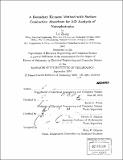| dc.contributor.advisor | Jacob K. White and Steven G. Johnson. | en_US |
| dc.contributor.author | Zhang, Lei, Ph. D. Massachusetts Institute of Technology. Department of Electrical Engineering and Computer Science | en_US |
| dc.contributor.other | Massachusetts Institute of Technology. Dept. of Electrical Engineering and Computer Science. | en_US |
| dc.date.accessioned | 2011-04-25T16:02:53Z | |
| dc.date.available | 2011-04-25T16:02:53Z | |
| dc.date.copyright | 2010 | en_US |
| dc.date.issued | 2010 | en_US |
| dc.identifier.uri | http://hdl.handle.net/1721.1/62462 | |
| dc.description | Thesis (Ph. D.)--Massachusetts Institute of Technology, Dept. of Electrical Engineering and Computer Science, 2010. | en_US |
| dc.description | Cataloged from PDF version of thesis. | en_US |
| dc.description | Includes bibliographical references (p. 127-132). | en_US |
| dc.description.abstract | Fast surface integral equation (SIE) solvers seem to be ideal approaches for simulating 3-D nanophotonic devices, as these devices generate fields both in an interior channel and in the infinite exterior domain. However, many devices of interest, such as optical couplers, have channels that cannot be terminated without generating reflections. Generating absorbers for these channels is a new problem for SIE methods, as the methods were initially developed for problems with finite surfaces. In this thesis, we show that the obvious approach for eliminating reflections, making the channel mildly conductive outside the domain of interest, is inaccurate. We propose a new method in which the absorber has gradually increasing surface conductivity; such an absorber can be easily incorporated in fast integral equation solvers. We present two types of PMCHW-based formulations to incorporate the surface conductivity into the SIE method. The accuracy of the two-type formulations are examined and discussed using an example of the scattering of a Mie sphere with surface conductivities. Moreover, we implement two different FFT-accelerated algorithms for the periodic non-absorbing region and the non-periodic absorbing region. In addition, we use perturbation theory and Poynting's theorem, respectively, to calculate the field decay rate due to the surface conductivity. We show a saturation phenomenon when the electrical surface conductivity is large. However, we show that the saturation is not a problem for the surface absorber since the absorber typically operates in a small surface conductivity regime. We demonstrate the effectiveness of the surface conductive absorber by truncating a rectangular waveguide channel. Numerical results show that this new method is orders of magnitude more effective than a volume absorber. We also show that the transition reflection decreases in a power law with increasing the absorber length. We further apply the surface conductive absorber to terminate a waveguide with period-a sinusoidally corrugated sidewalls. We show that a surface absorber that can perform well when the periodic waveguide system is excited with a large group-velocity mode may fail when excited with a smaller group-velocity mode, and give an asymptotic relation between the surface absorber length, transition reflections and group velocity. Numerical results are given to validate the asymptotic prediction. | en_US |
| dc.description.statementofresponsibility | by Lei Zhang. | en_US |
| dc.format.extent | 132 p. | en_US |
| dc.language.iso | eng | en_US |
| dc.publisher | Massachusetts Institute of Technology | en_US |
| dc.rights | M.I.T. theses are protected by
copyright. They may be viewed from this source for any purpose, but
reproduction or distribution in any format is prohibited without written
permission. See provided URL for inquiries about permission. | en_US |
| dc.rights.uri | http://dspace.mit.edu/handle/1721.1/7582 | en_US |
| dc.subject | Electrical Engineering and Computer Science. | en_US |
| dc.title | A boundary element method with surface conductive absorbers for 3-D analysis of nanophotonics | en_US |
| dc.type | Thesis | en_US |
| dc.description.degree | Ph.D. | en_US |
| dc.contributor.department | Massachusetts Institute of Technology. Department of Electrical Engineering and Computer Science | |
| dc.identifier.oclc | 711238511 | en_US |
